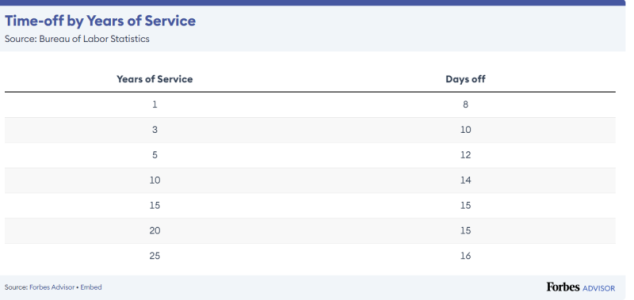I've posted a whole lot of discussion, backed up by data. You've posted personal anecdotes and no data to back them up. What else is there to say? I don't care about your personal situation any more than you care about mine. Neither one of us matters when we're talkin about averages and the overall situation. There's no point in reiterating that information.
The reality is that the American economy and labor force, like that of other developed nations, provides more benefits to skilled workers than to unskilled workers (again, using the technical terms) and those benefits include increased paid time off. The BLS backs me up on this. You've provided no data to counter this reality. So, what's the point, here?
Some specific responses.
1. No, of course a company doesn't classify workers as skilled or unskilled and then assign them benefits based on that classification. No, of course there isn't a solid line between the two groups of workers. No, there's no legal mandate for anything. But, on average, skilled works get more PTO than unskilled workers. All of the data that I could find supports this.
2. Since you mentioned it, my company starts at 3 weeks of PTO and adds two days per year so that after five years, you get 5 weeks of PTO. There are no further increases. Non-exempt employees, who often work "unskilled" jobs, or are part-time workers, receive less PTO, but they still start at two weeks.
3. I'm not trying to argue that Americans get as much PTO as Europeans. Of course, that's not true for most people. I was simply trying to show that the gap isn't as drastic as the initially quoted post implied.
4. When you consider the large population of the United States (more than France, Germany, Spain, Italy, and the UK combined), it doesn't really matter if the bottom 50% of workers (ranked by available PTO) don't have enough PTO. There are still tons of Americans with plenty of PTO to take European Disney cruises.
Your data isn't any different than my comments. Your data you're using is saying the more you work in terms of years the more vacation time you get. That's what I've been saying all along.
Where we've been disagreeing is a blanket assertation that being considered skilled labor under the Bureau of Labor and Statistics means you are getting more PTO than someone who is not. And your data set is "Average paid holidays and days of vacation and sick leave for full-time employees in small private establishments, 1996"
You've already mentioned the time gap of 1996 so that doesn't need repeating but the part you're missing here is also how PTO has evolved. With my husband's prior company I forget when (within the last 7 or so years) they merged sick time into PTO. The old sick days remained but carried heavy restrictions on when it could be used. Small private establishments is a limiting factor too. Looking at the cliff notes it was for companies that had less than 100 employees via a survey. Only using what you've posted it's hard to extrapolate that out to what is today's standards with what goes on with small, medium, and large companies.
None of the conversation was about population it was about how other countries view employee protections and structure that into their laws because while this is a Board that has a lot of Americans there are other posters who are citizens of other countries who frequently remark how it is for their country and how they view ours.
The issue I took with your original comments is because of how you 1) Talked about yourself 2) presented it in such as way that less skilled would get less. The key problem with you pushing only a data set but interjecting your personal situation as well as remarking that skilled typically would get the same as you is you open yourself up to the antidotes you are annoyed about hearing. So if you don't want to hear about how it actually IS for other people then don't talk about how it is for you and extrapolate that out to others. It's going to open the conversation for people to say "wait a minute that's not how it is" and you've got several posters describing their lives with other people included in that.
Here's a recent discussion from Forbes
https://www.forbes.com/advisor/business/pto-statistics/#:~:text=The average American worker gets,service increases to 15 days.
I've copied the more relevant part:
When it comes to annual vacation days, numbers vary greatly. There is no hard and fast number employers in the United States must follow. The underlining is mine and was what I was trying to get at.
The average American worker gets 11 days of paid vacation per year
In the private sector, the average number of paid vacation days after five years of service increases to 15 days.
4 After 10 years of service, it rises again to 17 days. For employees with 20 years of service or more, the average number of paid vacation days is 20. Keep in mind that these are strictly averages as there is no guaranteed PTO in the U.S.
On average, U.S. workers get eight days of sick leave per year
There is often a connection between how many sick days an American worker gets and their employment status. In general, the more often they work and longer they’ve been in their position, the more sick days they receive. The average number of paid sick days is as follows:
4
- Eight days per year for full-time workers
- Six days per year for part-time workers
- Eight days per year for workers who received a fixed number of paid sick days after one year of service
- Ten days per year for union workers, after one year of service
- Seven days per year for nonunion workers, after one year of service
The average employee in the U.S. receives an average of 7.6 paid holidays
Though the national average is 7.6, statistics show that 21% of U.S. employees receive six paid holidays per year.
4 The most common paid holidays in the United States are Thanksgiving, Christmas, Independence Day, New Year’s Day, Memorial Day and Labor Day. Of course, some employers give their workers more or less paid holidays. They may even offer floating holidays, which are paid days off that workers can take at any time during the year.
Federal employees have 11 annual paid holidays
While PTO is optional, there are certain paid holidays that are legally required for federal workers in the U.S. These holidays for federal employees include:
5
- New Year’s Day (January 1)
- Birthday of Martin Luther King, Jr. (Third Monday in January)
- Washington’s Birthday (Third Monday in February)
- Memorial Day (Last Monday in May)
- Juneteenth. National Independence Day (June 19)
- Independence Day (July 4)
- Labor Day (First Monday in September)
- Columbus Day (Second Monday in October)
- Veterans Day (November 11)
- Thanksgiving Day (Fourth Thursday in November)
- Christmas Day (December 25)
To give you info from my husband he does not get MLK off, does not get Washington's birthday off, does not get Juneteenth off, does not get Columbus Day off, does not get Veterans Day off. His prior company opted to add Good Friday off, his present company removed Good Friday off but added a floating holiday instead.
Average Paid Leave by Years of Service
The amount of time a worker has been with a company often impacts how much PTO they receive. In general, paid time off increases with years of service with a business.
4
The average paid time off for full-time employees in the United States is as follows:

The article did discuss that in the tech industry the move has been more to unlimited PTO and antidotally I can say that seems to pan out to be true. As an example Perceptive Software was headquartered here and they were one of the first companies in my area I remember hearing making the switch to unlimited PTO.


